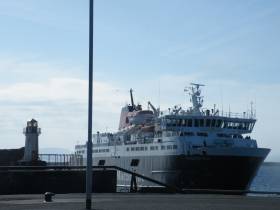Displaying items by tag: ABP Ports Relocation
UK Ports Operator Offers Funding If Arran Ferry Switches Scottish Port
#PortRelocation? - A large UK ports operator proposes to donate community funding to the Isle of Arran, if the island’s lifeline ferry service on the Firth of Clyde relocates to one of its owned ports, writes Jehan Ashmore.
The ports company, Associated British Ports (ABP) plans to create an Arran Community Fund, which will generate £50,000 a year, or around £1,000 a week, to benefit the island community. As part of an original deal (see below), the ferry port on the mainland at Ardrossan that serves Brodick (Arran) operated by Caledonian MacBrayne (CalMac) would transfer to neighbouring Troon.
As previously reported by Afloat.ie, Troon was last in use by P&O Ferries to Larne, until seasonal fast-ferry services closed in 2015, leaving an existing Larne-Cairnryan service on the North Channel to compete with Stena Line's Belfast-Cairnryan alternative.
It is claimed by ABP that the current ferryport, Ardrossan, also on the Ayrshire coast, is dogged by weather conditions that frequently exceed the capabilities of the port and result in a significant level of service cancellations. Approximately 150 crossings were cancelled last year, causing major issues for the travelling public and tourists trying to visit the island, dubbed ‘Scotland in miniature’.
The Ardrossan-Brodick route is served by Caledonian Isles and additional capacity in summer by Isle of Arran that also operates a seasonal-route out of Ardrossan to Campbeltown, Mull of Kintyre. This summer was the route’s first season as a ‘permanent’ service after a three year pilot programme.
ABP has already announced plans to invest £8 million in Troon, where the state-of-the-art passenger ferry terminal would serve the Isle of Arran. In contrast to Ardrossan, comparable journey times using Troon’s sheltered harbour offers the prospect of a reliable service for islanders, largely unaffected by adverse weather conditions.
Troon also offers improved road and increased rail connections, with access to the upgraded A77/M77 motorway and four trains per hour to Glasgow.
Afloat this summer featured the route from Ardrossan to the island’s ferryport at Brodick, to include coverage of the redevelopment work at the terminal on Arran by operator, CalMac.
The public funded ferry company which serves the Hebrides & Clyde Isles extensively, won the EU tender ferry bid from Transport Scotland in a £900m contract for the next eight years which began at the start of this month. It should be noted ABP Ports port relocation formed part of its application among those submitted for the Western Isles ferry contract.
The next generation of a pair of larger ferries for CalMac under construction on the Clyde, in which as least one vessel is destined for the Arran route. According to ABP, these newbuilds will too be able to use Troon’s existing 160-metre berth, which is well equipped to handle the 1,000 passenger/ 127 cars/16 HGV's (or combination) ferry sisters.
























































